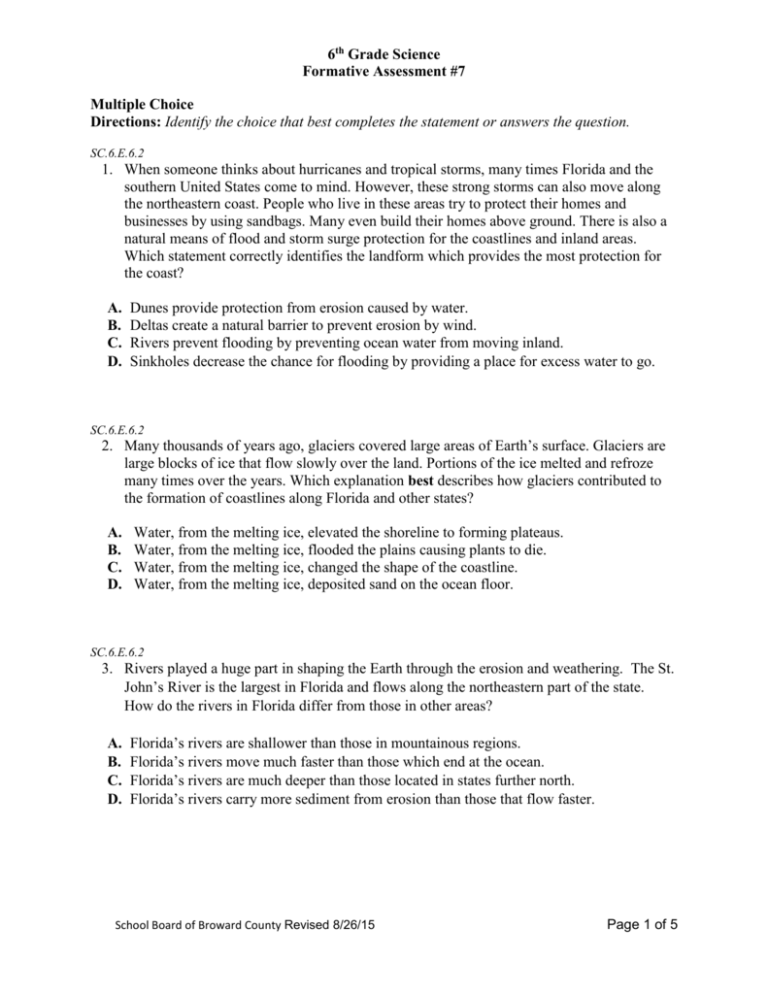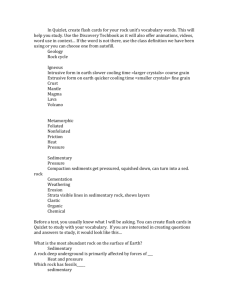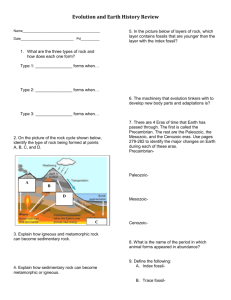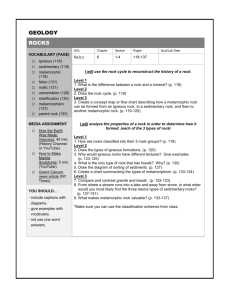Answer Key: 6th Grade Science Formative
advertisement

6th Grade Science Formative Assessment #7 Multiple Choice Directions: Identify the choice that best completes the statement or answers the question. SC.6.E.6.2 1. When someone thinks about hurricanes and tropical storms, many times Florida and the southern United States come to mind. However, these strong storms can also move along the northeastern coast. People who live in these areas try to protect their homes and businesses by using sandbags. Many even build their homes above ground. There is also a natural means of flood and storm surge protection for the coastlines and inland areas. Which statement correctly identifies the landform which provides the most protection for the coast? A. B. C. D. Dunes provide protection from erosion caused by water. Deltas create a natural barrier to prevent erosion by wind. Rivers prevent flooding by preventing ocean water from moving inland. Sinkholes decrease the chance for flooding by providing a place for excess water to go. SC.6.E.6.2 2. Many thousands of years ago, glaciers covered large areas of Earth’s surface. Glaciers are large blocks of ice that flow slowly over the land. Portions of the ice melted and refroze many times over the years. Which explanation best describes how glaciers contributed to the formation of coastlines along Florida and other states? A. B. C. D. Water, from the melting ice, elevated the shoreline to forming plateaus. Water, from the melting ice, flooded the plains causing plants to die. Water, from the melting ice, changed the shape of the coastline. Water, from the melting ice, deposited sand on the ocean floor. SC.6.E.6.2 3. Rivers played a huge part in shaping the Earth through the erosion and weathering. The St. John’s River is the largest in Florida and flows along the northeastern part of the state. How do the rivers in Florida differ from those in other areas? A. B. C. D. Florida’s rivers are shallower than those in mountainous regions. Florida’s rivers move much faster than those which end at the ocean. Florida’s rivers are much deeper than those located in states further north. Florida’s rivers carry more sediment from erosion than those that flow faster. School Board of Broward County Revised 8/26/15 Page 1 of 5 6th Grade Science Formative Assessment #7 SC.6.E.6.2 4. Some landforms in Florida have different characteristics than the same type of landform in other states. Which of the following statements correctly differentiates one type of Florida landform from those in other states? A. Florida’s rivers do not flow into the oceans, as do other U. S. rivers. B. Mountain ranges in Florida are short in comparison to the mountain ranges in other states. C. Dunes in Florida are larger than dunes which form in the deserts of the western United States. D. Lakes in Florida may be shallow as compared to other areas or are formed as the result of sinkholes. SC.6.E.6.2 5. Which of the following BEST describes the many rivers that flow through the state of Florida? A. Florida’s rivers are very deep as a result of the force of the water rushing down mountains. B. Florida’s rivers are very slow due to the flatness of the terrain. C. Florida’s rivers are very swifts and cause much erosion. D. Florida’s rivers always begin at the coastline. SC.7.E.6.2 6. The illustration below uses arrows to show how Earth’s tectonic plates move. Which statement below best describes where and why a particular type of rock may be found? A. Metamorphic rock may be found at location B, where magma escapes from the area where oceanic crust dives under continental crust. B. Sedimentary rock may be found at location A, where it is formed from melting and solidifying sediments. C. Metamorphic rock may be found at location A, where pressure and heat is supplied by the layers above. D. Sedimentary rock may be found at location B, where rock has been weathered by water to form sand. School Board of Broward County Revised 8/26/15 Page 2 of 5 6th Grade Science Formative Assessment #7 SC.7.E.6.2 7. Granite is a light colored igneous rock found in the mountains. When granite weathers, it breaks down into larger grains of sand and much smaller particles of silt and clay. These pieces roll down the sides of the mountain and form piles. After many years, what type of rock would most likely be formed at the foot of a mountain? A. Metamorphic rock will form due to the pressure caused by the movement of the mountain. B. Magma rock is formed from the intense heat released from the volcanic mountain. C. Sedimentary rock will form as the layers sand, silt and clay are pressed together. D. Igneous rock will form since all mountains are formed from volcanoes. SC.7.E.6.2 8. At certain points along the ocean floor, areas of spreading occur, creating Mid-ocean ridges. Along these areas new rock is formed. How is rock most likely formed along these ridges? Use the illustration below to help answer the question. A. Metamorphic rock is formed in the areas of new rock due to being under pressure from the ocean above. B. Igneous rock is formed from molten magma, being pushed up through the separation in the ocean floor, then cooled by seawater. C. Sedimentary Rock is formed as the sand, from the bottom of the ocean, keeps piling up in layers and then is cemented together by magma. D. Metamorphic rock is formed as heated rock, located near the mid-ocean ridge, is layered at the bottom of the ocean, then compressed by gravity. School Board of Broward County Revised 8/26/15 Page 3 of 5 6th Grade Science Formative Assessment #7 SC.7.E.6.2 9. While studying rocks in Hawaii, a geologist discovered an abundance of igneous rock. Which of the statements below best describes how this rock most likely formed? A. B. C. D. Sedimentary rock melted then cooled to become igneous rock. Metamorphic rock melted then cooled to become igneous rock. Metamorphic rock was weathered then melted to become igneous rock Either metamorphic or sedimentary rock was melted then cooled to form igneous rock. SC.7.E.6.2 10. Two groups of students were asked to create a simulation of the rock cycle. The following lists the order of the steps each group used. Group 1 Group 2 Which statement correctly indicates why one of the group’s steps were accurate or inaccurate? A. Group 1 was accurate since metamorphic rock must melt then cool in order to change to igneous rock. B. Group 2’s model was inaccurate because heat and pressure will not change a sedimentary rock to a metamorphic rock. C. Group 1 was inaccurate because sedimentary rock cannot be made from weathering, erosion of and cementation of igneous rock. D. Group 2 was accurate due to the fact that metamorphic rock must be weathered and then cemented before igneous rock can be produced. School Board of Broward County Revised 8/26/15 Page 4 of 5 6th Grade Science Formative Assessment #7 Answer Key: 6th Grade Science Formative Assessment #7 Question 1 2 3 4 5 6 7 8 9 10 Benchmark Answer SC.6.E.6.2 SC.6.E.6.2 SC.6.E.6.2 SC.6.E.6.2 SC.6.E.6.2 A C A D B SC.7.E.6.2 SC.7.E.6.2 SC.7.E.6.2 SC.7.E.6.2 SC.7.E.6.2 C C B D A School Board of Broward County Revised 8/26/15 DOK 2 2 2 2 2 3 3 3 3 3 Page 5 of 5







